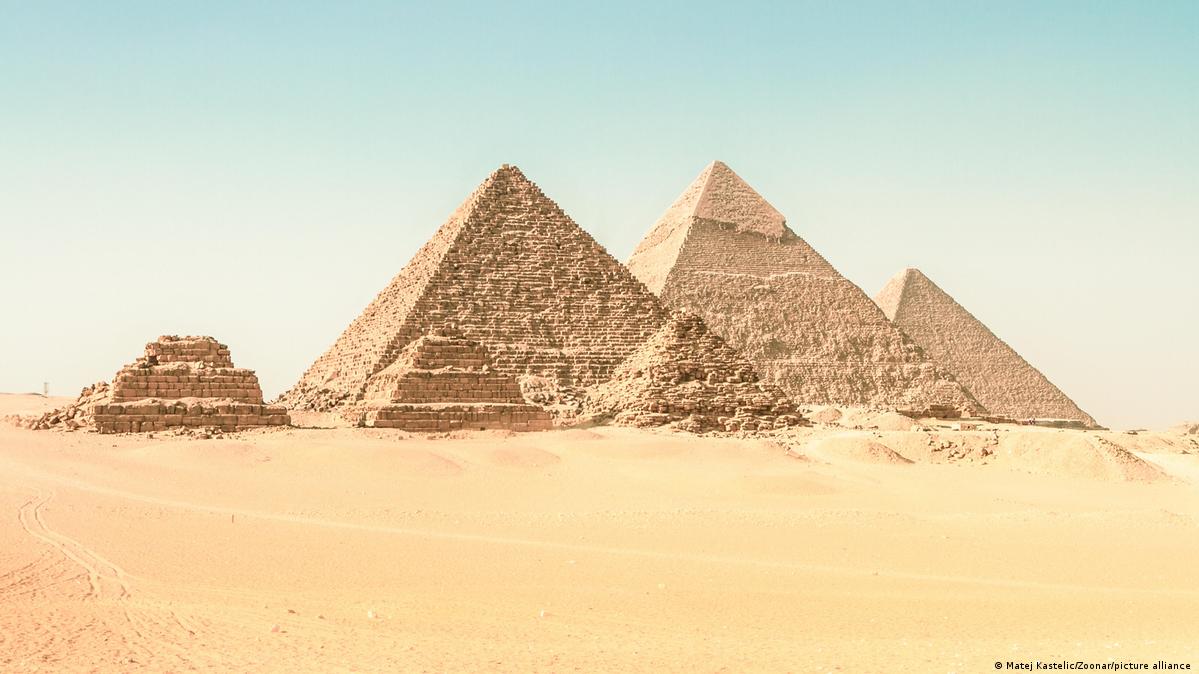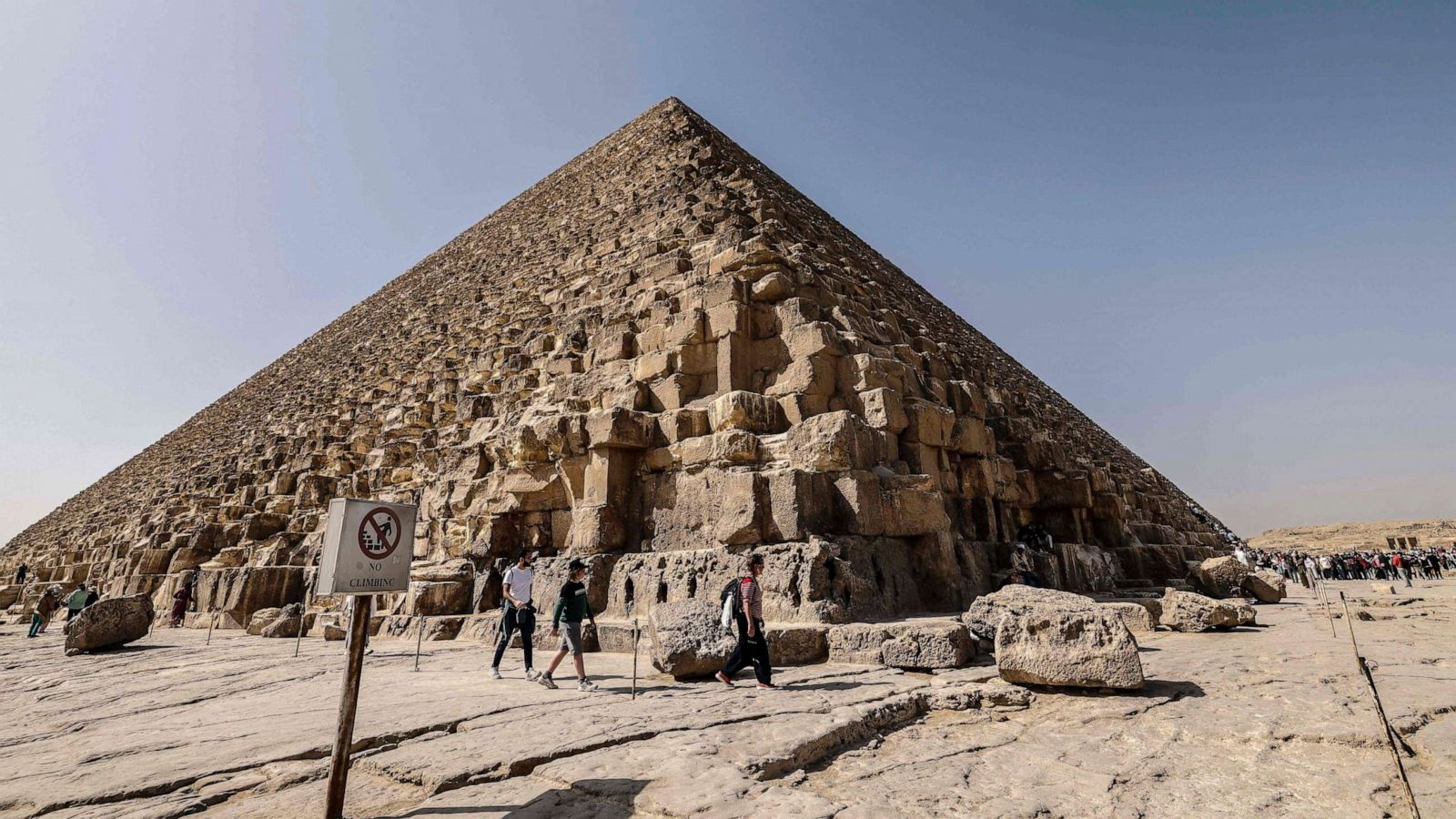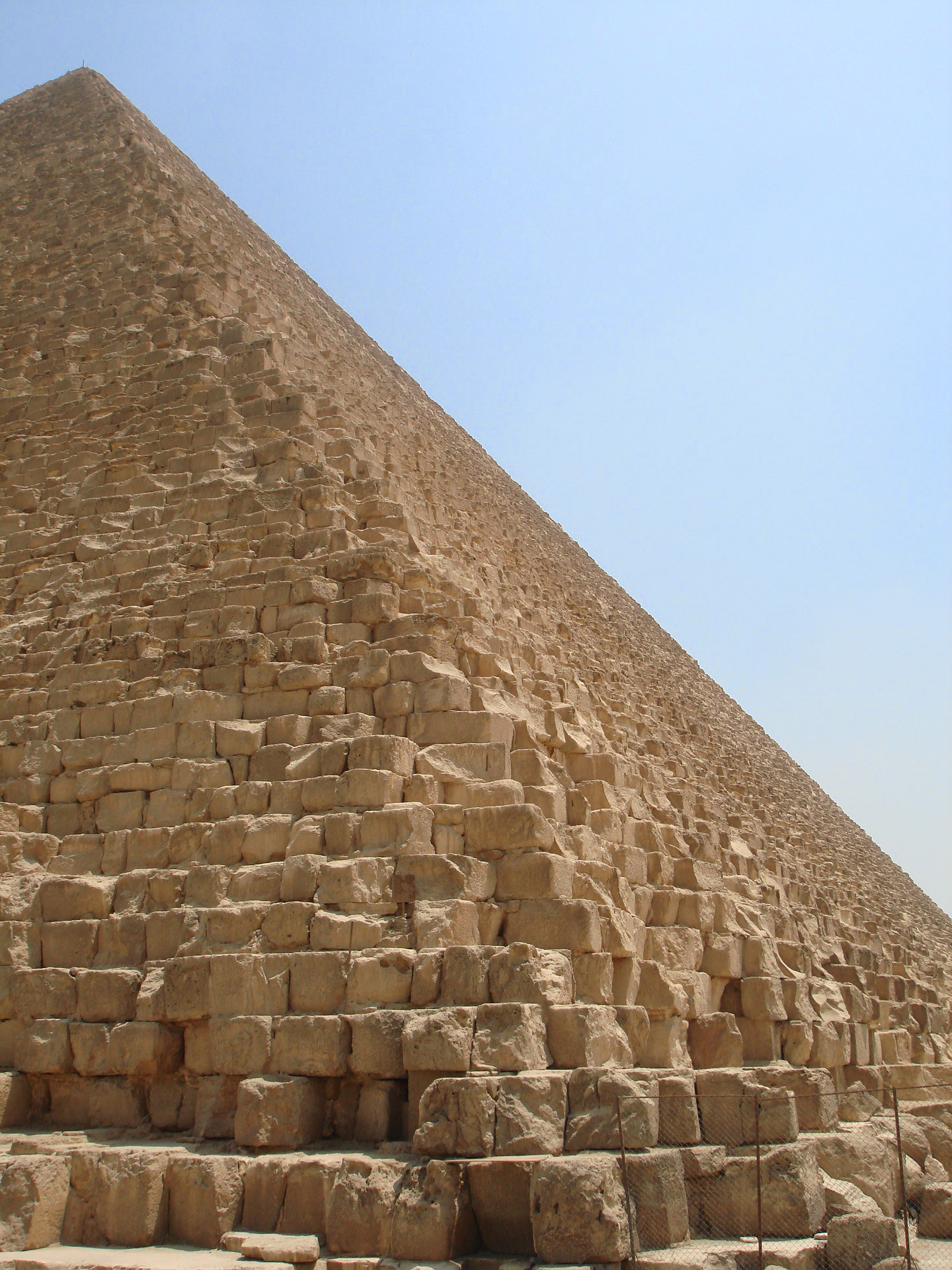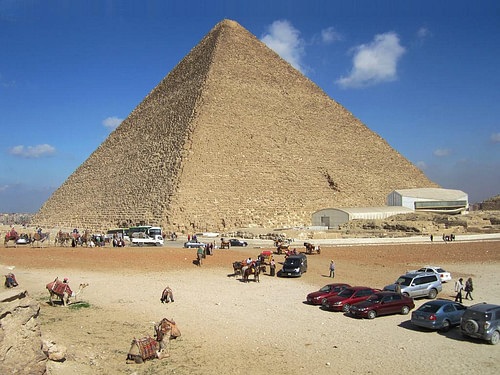The Great Pyramid of Khufu: A Wonder of the Ancient World
Standing majestically in the desert of Giza, the Great Pyramid of Khufu is considered one of the most impressive architectural feats of the ancient world. Constructed over 4,500 years ago, this pyramid is the largest of the three pyramids in Giza and an engineering marvel that took over 20 years to build. As a testament to the ingenuity of the ancient Egyptian civilization, the Great Pyramid of Khufu never fails to astound visitors with its massive limestone blocks and intricate design. In this blog post, we'll delve deeper into the history, culture, and symbolism surrounding this wonder of the ancient world.

Introduction to the Great Pyramid of Khufu
Explore the fascinating world of the Great Pyramid of Khufu, one of the Seven Wonders of the Ancient World, and be awed at the magnitude of the structure that stands today. Upon its construction, it was the tallest man-made structure, standing at 146.6 meters, dominating the skyline of the Giza Necropolis in Egypt. The Great Pyramid of Khufu is the largest of all pyramids and the only one to remain largely intact, making it a must-see destination for travellers and history buffs alike. Its sheer size and age are a testament to the skills and determination of the ancient Egyptians, a civilization that rose to prominence over 4,000 years ago.
Its internal structure is one of the most remarkable features of the Great Pyramid of Khufu. The pyramid comprises approximately 2.3 million limestone blocks, some weighing over 80 tonnes, and was constructed over 27 years. It houses three known chambers: the unfinished lowest chamber, the Queen's Chamber, and the King's Chamber, which contains a granite sarcophagus believed to hold the remains of Pharaoh Khufu, the ruler of Egypt during the Fourth Dynasty. The pyramid's construction techniques remain a mystery today, and different scientific and alternative hypotheses fascinate scholars and visitors alike.
The Great Pyramid of Khufu reveals much about ancient Egyptian beliefs and practices. The complex surrounding the pyramid consisted of two temples, an underground chamber, and five carefully placed boats believed to carry the pharaoh's soul across the river to the afterlife. The pyramid's significance and longevity continue to raise intrigue and wonder, and it remains a symbol of the ancient world's power and architectural prowess. Despite centuries of wear and tear, the Great Pyramid of Khufu inspires and captivates people worldwide, a testament to humanity's incredible potential to create something larger than life. [1][2]

Location and History of the Pyramid
If you ever find yourself in Egypt, visiting the Great Pyramid of Khufu is an absolute must. Located in the Giza Necropolis, just outside of Cairo, this pyramid is an incredible feat of engineering and craftsmanship. Its construction dates back to the early part of the fourth dynasty, around 27 years. Khufu, believed to be the pharaoh for whom the pyramid was built, ruled Egypt during this time. Despite being the oldest of the pyramids in Giza and the only one remaining largely intact, the Great Pyramid of Khufu was the largest structure in the world for over 3,800 years until the construction of Lincoln Cathedral in the 14th century. However, despite its age, it still stands tall and proud, attracting tourists worldwide.
The Great Pyramid of Khufu is a true testament to the skill and technology of the ancient Egyptians. The pyramid was constructed using over two million large blocks of stone, some weighing as much as 80 tonnes each. These were transported from nearby quarries to the construction site, which was no small feat given the technology available. The stones were then expertly cut and arranged in layers, with each layer gradually sloping inward as the pyramid got higher. Once the construction was complete, the entire pyramid was covered in a smooth layer of white limestone, giving it a polished and majestic appearance.
Despite its fame and status as one of the Wonders of the Ancient World, the Great Pyramid of Khufu remains shrouded in mystery. Historians and archaeologists have been studying the pyramid for centuries, yet many aspects of its construction and purpose continue to elude us. Some theories suggest that it may have been used as a burial site for Khufu himself. In contrast, others suggest that it was part of a larger complex used for astronomical observations or even religious ceremonies. Whatever its true purpose, there's no denying the awe-inspiring beauty and impressive scale of this ancient wonder. [3][4]

Construction theories and techniques
The Great Pyramid of Khufu, one of the Seven Wonders of the Ancient World, is one of the most awe-inspiring architectural accomplishments ever created. The pyramid was built by Pharaoh Khufu around 2500 B.C.E. and is a true feat of engineering and design. The pyramid's construction involved massive blocks of limestone quarried locally and transported to the site by people. The casing blocks were laid precisely, and spaces were filled with gypsum plaster, giving the pyramid a smooth surface.
The pyramid also contains hundreds of thousands of blocks, some weighing up to 50 tons, all of which were moved into place without modern equipment. Despite the challenges of the time, the builders made impressive architectural achievements, with a base length of more than 230 meters per side and a mere 1 3/4 inch difference in length among the four sides.
Many theories have been put forth about how the pyramid was designed, and the most recent surveys indicate that its orientation to the north deviates only 3' 6" and is precise, indicating the importance of the structure to its architects and builders. Some suggest that the pyramid was designed based on the golden ratio; others point to the π theory that argues it was created using mathematical constants. However, a new theory suggests that the pyramid's design was based on the 4th dynasty Egyptian canons of the proportion of the human form.
The Great Pyramid of Khufu stands as a testament to the incredible engineering prowess of ancient civilization. The construction techniques and theories used to build the pyramid are truly remarkable, and the structure remains one of the most impressive ever constructed. Whether built on mathematical precision or purely human intuition, the pyramid remains a wonder that continues to capture people's imaginations worldwide. [5][6]

Size and scale of the pyramid
The Great Pyramid of Khufu is truly a wonder of the ancient world. Standing at 146 meters (481 feet), it was the tallest structure on Earth until 1221 C.E. when Old St. Paul’s Cathedral surpassed it. With a base length of more than 230 meters (750 feet) per side, the precision with which it was constructed is impressive. Even with modern equipment, it would be a challenge to replicate today. The pyramid contains an estimated 2,300,000 blocks, some weighing over 50 tons. And yet, the ancient Egyptians could quarry and transport these massive stones to the construction site to create this monumental structure.
The pyramid was designed using both inner core stones and outer casing stones that were laid with great precision, as would have been the capstone that sat at the very top of the pyramid. Khufu's pyramid's interior chambers and passageways are also enigmatic, containing features such as an unfinished subterranean chamber and several ‘air shafts’ that radiate out from the upper chambers. When entering the pyramid, one must crawl up a cramped ascending chamber that opens suddenly into a grand space. The funerary complex around the pyramid consisted of two connected pyramid tombs for the immediate family and the court of Khufu, including three smaller pyramids for his wives, an even smaller satellite pyramid, and five buried boats.
Despite being the oldest of the three main pyramids of Giza, the Great Pyramid remains largely intact today. Over time, most of the smooth white limestone casing that made it shine and reflect light was removed, reducing the pyramid's height to its current 138.5 meters (454.4 feet). Now, people see the underlying core structure of the pyramid that has stood the test of time. Exploring and learning about the Great Pyramid of Khufu is a fantastic way to appreciate the greatness of the ancient civilization that created it. [7][8]

Workers and labour involved in the construction
Do you ever wonder how the Great Pyramid of Khufu, one of the seven wonders of the ancient world, was built? It is estimated that the pyramid's construction took around 27 years, with a workforce of up to 100,000 labourers. Although it is a popular belief that slaves built the pyramid, the evidence suggests that the workers were paid, labourers. The remains of these builders were found in a burial place of honour near the pyramids.
An estimated 2.3 million large blocks weighing 6 million tons were used to construct the Great Pyramid of Khufu. Most stones were not uniform in size or shape and were only roughly dressed. The outside layers were bound together by mortar. The primary material used was locally sourced limestone. Blocks were also imported by boat on the Nile, such as white limestone from Tura for the casing and blocks from Aswan weighing up to 80 tonnes for the King’s Chamber structure.
The construction techniques used in building the Great Pyramid remain a mystery. Several hypotheses attempt to explain the exact construction techniques, but none have been conclusive. Some people believe that Khufu was the architect, while others think it was the work of a highly organized team of builders. Nevertheless, the precision with which the work was executed remains remarkable. The pyramid stands at a height of 138.5 meters (454.4 feet), and its base measures about 230.3 meters (755.6 feet) with a volume of roughly 2.6 million cubic meters (92 million cubic feet).
The Great Pyramid of Khufu is a wonder of the ancient world and a demonstration of human ingenuity and engineering skills. Its construction required a massive workforce and incredible precision of work. Undoubtedly, it is a testament to the hard work of the paid labourers who built this wonder of the ancient world. [9][10]

The complex of pyramids and tombs surrounding the Great Pyramid
The Great Pyramid of Khufu is a wonder of the ancient world that stands out among its peers. Being the largest of the three main pyramids in Giza and at the height of 146 meters, the Great Pyramid remained the tallest structure in the world for nearly 3,800 years until the steeple of Old St. Paul's Cathedral surpassed it in 1221 C.E. Despite its colossal size, the precision with which the Great Pyramid was built is astonishing. The layout of the pyramid and its measurements are accurate, with only a 4.4 cm difference in length among its four sides, which is an incredible accomplishment even with modern technology.
The Great Pyramid of Khufu comprises an estimated 2.3 million blocks, primarily rough-hewn, locally quarried core stones with angled outer casing blocks filled with gypsum plaster. The outer casing stones, which have been removed, were laid with incredible precision, enhancing the pyramid's appearance. The fine outer casing stones, made of white Tura limestone, gave the Great Pyramid a smooth surface and made it bright and reflective. At the pyramid's peak sat a capstone known as a pyramidion that may have been covered in gold. Even though this capstone is not in existence today, it was a glorious point shining in the intense sunlight, visible from a great distance.
The Great Pyramid of Khufu is home to several enigmatic features that have puzzled historians and explorers for centuries. The interior chambers and passageways of the pyramid differ from other pyramids and tombs, including an unfinished subterranean chamber with a mysterious function and several air shafts that radiate out from the upper chambers. Although these have been explored with small robots, several blocking stones have obscured the passages. Upon entering the Great Pyramid, one must crawl up a cramped ascending chamber, which suddenly opens into a remarkable space. The complex of pyramids and tombs surrounding the Great Pyramid includes one close to the pyramid and one near the Nile, tombs for the immediate family and court of Khufu, including three smaller pyramids for Khufu's wives, an even smaller satellite pyramid, and five buried boats. [11][12]

Chambers and sarcophagus inside the Great Pyramid
As you enter the Great Pyramid, remember that this monument is a burial place. It was commissioned by the Pharaoh Khufu and built by his subjects over 4500 years ago using primitive tools like copper chisels. The King's Chamber, located within the Great Pyramid, is home to the sarcophagus of Khufu, although it is empty today. Nevertheless, the sarcophagus still holds historical and cultural significance as it is made of solid red granite and weighs over 8 tons. Its construction, shipping, and placement are an engineering feat not easily replicated today.
To reach the King's Chamber, visitors must navigate through narrow passageways and climb steep inclines. This can be daunting for those who are claustrophobic or have mobility issues. There are also traps in certain passages to prevent tomb robbers from raiding the pyramid and stealing the treasures buried alongside the Pharaoh. Once inside the chamber, the visitors will notice the simple decoration and the austere nature of the room. It is a reminder that this is not a palace or a temple but a place of eternal rest.
Despite the architectural and engineering marvels that make up the Great Pyramid, the mystery shrouding its purpose and construction captivates visitors from all over the world. There are many theories and speculations about the pyramid’s construction, some even more fascinating than the reality. Regardless of the veracity of these theories, it is undeniable that the Great Pyramid holds a unique place in the world's cultural heritage. It symbolises human perseverance and ingenuity, a witness to a civilization long gone but not forgotten. [13][14]

Attribution of the pyramid to Pharaoh Khufu
When you gaze upon the Great Pyramid of Khufu, it's hard to fathom the sheer magnitude and precision of the structure. This wonder of the ancient world stands at a height of 146 meters (481 feet), an impressive feat that remained unmatched by humans until over 3,000 years later. Despite being built over 4,500 years ago, the Great Pyramid has impressed visitors today with its accuracy. Its base length is over 230 meters (750 feet) per side, with the greatest difference in length among the four sides measuring a mere 4.4 cm (1 ¾ inches), and the base is levelled within 2.1 cm (less than an inch), an astounding achievement that modern-day builders would struggle to replicate.
The Great Pyramid was built under the reign of Pharaoh Khufu, and the structure's size, scale, and sophistication suggest his use of vast resources, labour, and architectural knowledge. Over 2 million blocks of stone, some weighing over 50 tons each, were used in the construction, and the inner core stones and outer casing blocks were laid in horizontal courses with great precision. The pyramid's surface was also adorned with sleek white limestone, arranged with such care that the structure had an incredibly smooth finish. At the apex of the pyramid was placed a pyramidion, possibly covered in gold, making it a shining spectacle in the sunlight, which could be seen from miles away.
Inside the pyramid lies an array of unique features, such as an unfinished subterranean chamber and the so-called 'air shafts' that radiate from the upper chambers, whose purpose is still mysterious. Heading inside is a unique experience, where visitors must crawl up a cramped ascending chamber that opens up suddenly into the larger, grander space. It's hard to believe that this awe-inspiring structure, still admired today, was built over 4,500 years ago by the hands of ancient people. [15][16]

Changes to the pyramid over time, including the removal of casing
You're standing in front of one of the most awe-inspiring structures in the world, the Great Pyramid of Khufu. Believed to have been built over 4,500 years ago, this monumental tomb rises to an impressive height of 146 meters, a feat not surpassed until the 13th century AD. Over time, the pyramid has undergone changes, the most significant of which was the removal of its smooth white limestone casing. Once polished to perfection, the casing was stripped away long ago, reducing the pyramid's height to 139 meters. Despite this, the Great Pyramid is a testament to human ingenuity and skill.
Think about what it would have been like to watch as the pyramid was constructed piece by piece. Enormous stones weighing as much as 50 tons were cut and transported from nearby quarries, fitted together to create a solid inner core. This core was then covered by the pyramid's distinctive angled outer casing blocks, which were precisely laid in horizontal courses and filled with gypsum plaster. The finished product was a smooth and shining marvel visible from great distances. The pyramid's capstone, known as a pyramidion, would have been the crowning glory, catching the sun's rays and glinting like gold.
If you were to step inside the Great Pyramid today, you would find a labyrinth of passages and chambers that have fascinated archaeologists and historians for centuries. Among these are the grand burial chamber of Pharaoh Khufu, the pyramid's namesake, and several smaller chambers and corridors whose purpose remains a mystery. The pyramid's interior includes a series of air shafts that may have helped with ventilation or alignment with specific stars, and there's a subterranean chamber whose incomplete status has puzzled experts for generations. Despite these enigmas, the Great Pyramid of Khufu remains one of the most remarkable structures in the world, a monument to ancient Egypt's enduring culture and ingenuity. [17][18]

Significance and legacy of the Great Pyramid as a wonder of the ancient world.
The Great Pyramid of Khufu is an architectural masterpiece that has stood the test of time. This pyramid, located in Giza, Egypt, is the largest of the three main pyramids and was built by Pharaoh Khufu in 2551-2528 BCE. It is an impressive structure that held the title of the world's tallest structure made by human hands for over 3000 years.
The pyramid's significance is not just in its height but also in its precision. Despite being built in ancient times without modern technology, the pyramid was constructed with incredible accuracy. With a base length of over 230 meters per side, the greatest difference in length among the four sides of the pyramid is just a mere one ¾ inches. This is a remarkable accomplishment that would be a challenge to replicate today, even with modern equipment.
The Great Pyramid of Khufu's legacy goes beyond its physical construction. It's interior design and enigmatic elements have stirred scientific curiosity. The interior chambers and passageways of the pyramid include several intriguing features, such as an unfinished subterranean chamber and a series of so-called 'air shafts' that radiate out from the upper chambers. And while many theories persist on how the pyramid was built, the most widely accepted understanding is that it was constructed as a tomb for king Khufu.
Today, the Great Pyramid of Khufu remains a popular tourist destination and a symbol of ancient Egypt's rich history and cultural advancements. It continues to inspire awe and wonder among visitors, and its legacy as a wonder of the ancient world lives on. [19][20]
